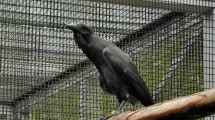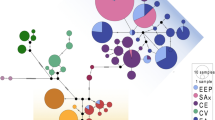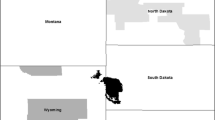Abstract
An insurance population for the critically endangered Tasmanian devil was established in 2006. Due to successful captive breeding, the population has reached its carrying capacity of 600 devils and retains 99.95 % of founding gene diversity. Although reproduction has been quite successful, possible relatedness among founding individuals, influences of genetic provenance and pairing success on female productivity were evaluated to further refine insurance population management. Ten polymorphic microsatellite markers were used to assess the founders. Although the data were ultimately insufficient for determining specific founder relationships, a STRUCTURE analysis determined founders to be of eastern or western provenance. Western provenance animals had an observed heterozygosity of 0.38; while eastern provenance was 0.41. Allelic frequencies between the two provenances were similar. Although differences in pairing success of eastern and western provenance animals were noted, there was no difference in overall productivity (number of joeys/female). Cross-provenance pairings were not as successful as W–W but had similar productivity, and produced viable offspring. Birth origin (wild-born vs. zoo-born) had no influence on pairing success but wild-born females produce significantly more joeys/female. For zoo-born females, the number of joeys produced per female had a downward trend between respective generations in captivity. Current and future population managers should be aware of potential reductions in productivity across captive generations and adjust breeding recommendations accordingly. The ability to recruit founders from diseased females, along with a better understanding of the influence of genetic provenance and birth origin on productivity, has led to changes in acquisition of future founders for this insurance population.



Similar content being viewed by others
References
Blouin MS, Parsons M, Lacaille V, Lotz S (1996) Use of microsatellite loci to classify individuals by relatedness. Mol Ecol 5(3):393–401
Brüniche-Olsen A, Jones ME, Austin JJ, Burridge CP, Holland BR (2014) Extensive population decline in the Tasmanian devil predates European settlement and devil facial tumour disease. Biol Lett. doi:10.1098/rsbl.2014.0619
CBSG (2008) Tasmanian Devil PHVA Final Report. IUCN/SSC Conservation Breeding Specialist Group, Apple Valley, MN
Edmands S (2007) Between a rock and a hard place: evaluating the relative risks of inbreeding and outbreeding for conservation and management. Mol Ecol 16:463–475. doi:10.1111/j.1365-294X.2006.03148.x
Evanno G, Regnaut S, Goudet J (2005) Detecting the number of clusters of individuals using the software STRUCTURE: a simulation study. Mol Ecol 14:2611–2620
Frankham R (2008) Genetic adaptation to captivity in species conservation programs. Mol Ecol 17:325–333. doi:10.1111/j.1365-294X.2007.03399.x
Frankham R, Ballou JD, Briscoe DA (2010) Introduction to conservation genetics, 2nd edn. Cambridge University Press, Cambridge
Frankham R, Ballou JD, Eldridge MDB, Lacy RC, Ralls K, Dudash MR, Fenster CB (2011) Predicting the probability of outbreeding depression. Conserv Biol 25:465–475. doi:10.1111/j.1523-1739.2011.01662.x
Hardy OJ, Vekemans X (2002) SPAGeDi: a versatile computer program to analyse spatial genetic structure at the individual or population levels. Mol Ecol Notes 2:618–620
Hawkins CE et al (2006) Emerging disease and population decline of an island endemic, the Tasmanian devil Sarcophilus harrisii. Biol Conserv 131:307–324
Hawkins CE, McCallum H, Mooney N, Jones M, Holdsworth M (2008) Sarcophilus harrisii. Version 2013.2
Hesterman H, Jones SM, Schwarzenberger F (2008) Reproductive endocrinology of the largest dasyurids: characterization of ovarian cycles by plasma and fecal steroid monitoring. Part I. The Tasmanian devil (Sarcophilus harrisii). Gen Comp Endocrinol 155:234–244
Hogg CJ, Srb C, Hockley J (2013) Annual Report for the DPIPWE-ZAA Tasmanian Devil Insurance Population. Zoo and Aquarium Association
Ivy JA, Lacy RC (2010) Using molecular methods to improve the genetic management of captive breeding programs for threatened species. In: DeWoody JA, Bickham JW, Michler CH, Nicols KM, Rhodes OE, Woeste KE (eds) Molecular approaches in natural resource conservation and management. Cambridge University Press, Cambridge, pp 267–295
Ivy JA, Miller A, Lacy RC, DeWoody JA (2009) Methods and prospects for using molecular data in captive breeding programs: an empirical example using parma wallabies (Macropus parma). J Hered 100:441–454. doi:10.1093/jhered/esp019
Iyengar A et al (2007) Remnants of ancient genetic diversity preserved within captive groups of scimitar-horned oryx (Oryx dammah). Mol Ecol 16:2436–2449. doi:10.1111/j.1365-294X.2007.03291.x
Jones ME, Paetkau D, Geffen E, Moritz C (2003) Microsatellites for the Tasmanian devil (Sarcophilus laniarius). Mol Ecol Notes 3:277–279. doi:10.1046/j.1471-8286.2003.00425.x
Jones ME, Paetkau D, Geffen E, Moritz C (2004) Genetic diversity and population structure of Tasmanian devils, the largest marsupial carnivore. Mol Ecol 13:2197–2209
Kleiman DG, Rylands AB (2002) Lion tamarins: biology and conservation. Smithsonian Institution Press, Washington, DC
Lachish S, McCallum H, Jones M (2009) Demography, disease and the devil: life-history changes in a disease-affected population of Tasmanian devils (Sarcophilus harrisii). J Anim Ecol 78:427–436. doi:10.1111/j.1365-2656.2008.01494.x
Lachish S, Miller KJ, Storfer A, Goldizen AW, Jones ME (2010) Evidence that disease-induced population decline changes genetic structure and alters dispersal patterns in the Tasmanian devil. Heredity 106:172–182
Lacy RC (1997) Importance of genetic variation to the viability of mammalian populations. J Mammal 78:320–335
Lacy RC, Ballou JD, Princée F, Starfield A, Thompson EA (1995) Pedigree analysis for population management. In: Ballou JD, Gilpin M, Foose TJ (eds) Population management for survival and recovery. Analytical methods and strategies in small population conservation. Columbia University Press, New York, pp 57–75
Lees C, Andrew P, Sharman A, Byers O (2013) Saving the devil: one species, one plan, WAZA Magazine, vol. 14, pp 37–40
Leus K, Traylor-Holzer K, Lacy RC (2011) Genetic and demographic population management in zoos and aquariums: recent developments, future challenges and opportunities for scientific research. Int Zoo Yearb 45:213–225
Lynch M, Ritland K (1999) Estimation of pairwise relatedness with molecular markers. Genetics 152:1753–1766
McCallum H et al (2007) Distribution and impacts of Tasmanian devil facial tumor disease. Ecohealth 4:318–325. doi:10.1007/s10393-007-0118-0
McCallum H et al (2009) Transmission dynamics of Tasmanian devil facial tumor disease may lead to disease-induced extinction. Ecology 90:3379–3392. doi:10.1890/08-1763.1
Miller W et al (2011) Genetic diversity and population structure of the endangered marsupial Sarcophilus harrisii (Tasmanian devil). Proc Natl Acad Sci USA 108:12348–12353. doi:10.1073/pnas.1102838108
Peakall R, Smouse PE (2006) GenAlEx 6: genetic analysis in Excel. Population genetic software for teaching and research. Mol Ecol Notes 6:288–295
Peakall R, Smouse PE (2012) GenAlEx 6.5: genetic analysis in Excel. Population genetic software for teaching and research—an update. Bioinformatics 28:2537–2539
Pimm SL et al (2014) The biodivserity of species and their rates of extinction, distribution, and protection. Science 344:1246752
Pritchard JK, Stephens M, Donnelly P (2000) Inference of population structure using multilocus genotype data. Genetics 155:945–959
Queller DC, Goodnight KF (1989) Estimating relatedness using genetic markers. Evolution 43:258–275
Rabon DR, Waddell W (2010) Effects of inbreeding on reproductive success, performance, litter size, and survival in captive red wolves (Canis rufus). Zoo Biol 29:36–49. doi:10.1002/zoo.20262
Ralls K, Ballou JD (2004) Genetic status and management of California condors. Condor 106:215–228
Rice WR (1989) Analyzing tables of statistical tests. Evolution 43:223–225
Roelle JE, Miller BJ, Godbey JL, Biggins DE (2006) Recovery of the black-footed ferret—progress and continuing challenges
Rollinson N, Keith DM, Houde ALS, Debes PV, McBride MC, Hutchings JA (2014) Risk assessment of inbreeding and outbreeding depression in a captive-breeding program. Conserv Biol 28:529–540. doi:10.1111/cobi.12188
Rousset F (2008) GENEPOP’007: a complete re-implementation of the GENEPOP software for Windows and Linux. Mol Ecol Resour 8:103–106
Rudnick JA, Lacy RC (2008) The impact of assumptions about founder relationships on the effectiveness of captive breeding strategies. Conserv Genet 9:1439–1450
Srb C (2006) ASMP Tasmanian devil. Annual Report and Recommendations, ARAZPA
Wang J (2002) An estimator for pairwise relatedness using molecular markers. Genetics 160:1203–1215
Wang J (2011) COANCESTRY: a program for simulating, estimating and analysing relatedness and inbreeding coefficients. Mol Ecol Resour 11:141–145
Weeks AR et al (2011) Assessing the benefits and risks of translocations in changing environments: a genetic perspective. Evol Appl 4:709–725
Williams ES, Thorne ET, Kwiatkowski DR, Anderson SL, Lutz K (1991) Reproductive-biology and management of captive black-footed ferrets (Mustela nigripes). Zoo Biol 10:383–398
Acknowledgments
There are, and have been, a significant number of contributors to the Tasmanian devil insurance population over the past 10 years. Although there are too many to name special thanks go to A. Kelly, P. Andrew, A. Sharman, M. Holdsworth, H. Williams, J. Hockley and H. Hesterman for their commitment to the establishment of the insurance population. Thanks also to the field teams who sourced the original founders, the countless keepers who work diligently to house, breed and transfer the animals, and most importantly the zoos who make a significant financial contribution through their housing of over 600 devils. Thank you to R. Frankham for his comments on the provenance pairing analysis in its early stages; and an anonymous reviewer for their comments. The insurance population has been facilitated and supported by the Save the Tasmanian Devil Program.
Compliance with Ethical Standards
All Tasmanian devil recruited as part of the insurance population where done so under permit and the standard operating procedure of the Tasmanian Department of Primary Industries, Population, Water and the Environment. This study was funded by the Save the Tasmanian Devil Program and the Zoo and Aquarium Association Australasia.
Conflict of interest
The authors declare that they have no conflict of interest.
Author information
Authors and Affiliations
Corresponding author
Rights and permissions
About this article
Cite this article
Hogg, C.J., Ivy, J.A., Srb, C. et al. Influence of genetic provenance and birth origin on productivity of the Tasmanian devil insurance population. Conserv Genet 16, 1465–1473 (2015). https://doi.org/10.1007/s10592-015-0754-9
Received:
Accepted:
Published:
Issue Date:
DOI: https://doi.org/10.1007/s10592-015-0754-9




